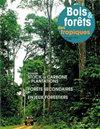Application of the BDq method to complex tropical mixed forest ecosystems in Nigeria
IF 0.6
4区 农林科学
Q3 FORESTRY
引用次数: 0
Abstract
The absence of management practice/silvicultural treatments in the complex tropical mixed forests of Nigeria has led to uncontrolled logging in natural forest stands and loss of biodiversity. To sustain production, protection and conservation in these complex tropical mixed stands, this study proposes the application of a selection method – the BDq method (B: basal area, D: maximum diameter, q-ratio) to manage these stands. Two strata were used as a pilot test: stratum 1 consisted of 15 plots and stratum 2 of 7 plots, each with an area of 0.25 ha. Only trees with a diameter at breast height (d) ≥ 10.0 cm were considered in this study. Harvesting with the BDq method was quantified, by setting B at 20 m2, 25 m2 and 30 m2/ha corresponding respectively to intensive, medium and light harvesting regimes. D was set at 65 cm and the q-ratio was computed for each plot. The results showed that the three BDq regimes prescribed (intensive, medium and light) yielded reasonable felling intensities (FI), derived as the percentage of extracted volume (Vext) and biomass (Wext). The Vext and FI for stratum 1 ranged from 39.94-62.30 m3/ha and 11.22-18.18%; the results for stratum 2 were 30.44-51.33 m3/ha and 10.02-17.57%. For biomass, the Wext and FI ranged from 18.46-29.82 t/ha and 9.40-15.95% for stratum 1 and 14.16-24.82 t/ha and 9.73-17.50% for stratum 2. These findings show that applying the BDq method to the complex tropical mixed forests of Nigeria would yield attractive stands.BDq方法在尼日利亚复杂热带混交林生态系统中的应用
尼日利亚复杂的热带混合林缺乏管理实践/造林处理,导致天然林砍伐失控,生物多样性丧失。为了维持这些复杂热带混合林分的生产、保护和养护,本研究提出了一种选择方法——BDq方法(B:基底面积,D:最大直径,q-ratio)来管理这些林分。使用两个地层作为试点试验:地层1由15个地块组成,地层2由7个地块组成。每个地块的面积为0.25公顷。本研究只考虑了胸径(d)≥10.0厘米的树木。通过将B分别设定为20 m2、25 m2和30 m2/ha,分别对应于集约、中等和轻度收割制度,对BDq方法的收割进行了量化。将D设定为65cm,并计算每个标的的q比。结果表明,规定的三种BDq方案(强化、中等和轻度)产生了合理的砍伐强度(FI),其表示为提取体积(Vect)和生物量(Wext)的百分比。第1层的Vect和FI范围为39.94-62.30 m3/ha和11.22-18.18%;第2层的Wext和FI分别为18.46-29.82和9.40-15.95%,第2层为14.16-24.82和9.73-17.50%。这些发现表明,将BDq方法应用于尼日利亚复杂的热带混交林将产生有吸引力的林分。
本文章由计算机程序翻译,如有差异,请以英文原文为准。
求助全文
约1分钟内获得全文
求助全文
来源期刊

Bois et Forets Des Tropiques
FORESTRY-
CiteScore
1.50
自引率
16.70%
发文量
31
审稿时长
>12 weeks
期刊介绍:
In 1947, the former Tropical Forest Technical Centre (CTFT), now part of CIRAD, created the journal Bois et Forêts des Tropiques. Since then, it has disseminated knowledge and research results on forests in intertropical and Mediterranean regions to more than sixty countries. The articles, peer evaluated and reviewed, are short, synthetic and accessible to researchers, engineers, technicians, students and decision-makers. They present original, innovative research results, inventions or discoveries. The journal publishes in an international dimension. The topics covered are of general interest and are aimed at an informed international audience.
 求助内容:
求助内容: 应助结果提醒方式:
应助结果提醒方式:


